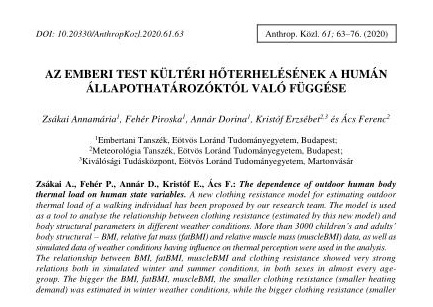Az emberi test kültéri hőterhelésének a humán állapothatározóktól való függése
Absztrakt
A new clothing resistance model for estimating outdoor thermal load of a walking individual has been proposed by our research team. The model is used as a tool to analyse the relationship between clothing resistance (estimated by this new model) and body structural parameters in different weather conditions. More than 3000 children’s and adults’ body structural – BMI, relative fat mass (fatBMI) and relative muscle mass (muscleBMI) data, as well as simulated data of weather conditions having influence on thermal perception were used in the analysis.
The relationship between BMI, fatBMI, muscleBMI and clothing resistance showed very strong relations both in simulated winter and summer conditions, in both sexes in almost every age-group. The bigger the BMI, fatBMI, muscleBMI, the smaller clothing resistance (smaller heating demand) was estimated in winter weather conditions, while the bigger clothing resistance (smaller cooling demand) was estimated in summer weather conditions. Females’ clothing resistance was higher in winter weather conditions, while was smaller in summer conditions than the clothing resistance of their male age-peers having the same relative body mass, fat mass or muscle mass. BMI showed the strongest relations with clothing resistance both in summer and winter thermal stresses. The preliminary results of the project confirmed that age, gender, BMI and presumably relative fat and muscle mass should be built in the procedure of parameterization of clothing resistance.
Hivatkozások
Ács, F., Zsákai, A., Kristóf, E., Szabó, A.I., Breuer, H. (2020a): Carpathian Basin climate according to Köppen and a clothing resistance scheme. Theoretical and Applied Climatology, 141: 299–307. DOI: 10.1007/s00704-020-03199-z
Ács, F., Zsákai, A., Kristóf, E., Szabó, A.I., Breuer, H. (2020b): Human thermal climate of the Carpathian Basin. International Journal of Climatology, megjelenés alatt. DOI: 10.1002/joc.6816
Barbat-Artigas, S., Pion, C.H., Leduc-Gaudet, J.P., Rolland, Y., Aubertin-Leheudre, M. (2014): Exploring the role of muscle mass, obesity, and age in relationship between muscle quality and physical function. Journal of the American Medical Directors Association, 15(4): 303–313.
Budyko, M., Cicenko, V. (1960): Climatic factors of human thermal sensation (in Russian). Izvestiya Rossiiskoi akademii nauk. Seriya geograficheskaya, 3: 3–11.
de Freitas, C.R., Grigorieva, EA. (2015): A comprehensive catalogue and classification of human thermal climate indices. International Journal of Biometeorology, 59: 109–120. DOI: 10.1007/s00484-014-0819-3
Fehér, P., Annár, D., Zsákai, A., Bodzsár, É. (2019): Pszichoszomatikus tünetek gyakoriságát befolyásoló tényezők 18–90 éves nők körében. Anthropologiai Közlemények, 60: 65–77. DOI: 10.20330/AnthropKozl.2019.60.65
Haldane, J.B.S. (1905): The influence of high air temperatures. Journal of Hygiene, 5: 494–513.
Kántor, N. (2012): Városi közterületek termikus komfortviszonyainak értékelése Szeged példáján különös tekintettel a látogatók szubjektív reakcióira. Doktori disszertáció. SZE, Szeged.
R Core Team (2020): R: A language and environment for statistical computing. R Foundation for Statistical Computing, Vienna, Austria. www.R-project.org
Tuomaala, P., Holopainen, R., Piira, K., Airaksinen, M. (2013): Impact of individual characteristics such as age, gender, BMI and fitness on human thermal sensation. In: Proceedings of thirteen Internatinal Building Performance Simulation Association conference. pp. 2305–2311.
Utczás, K., Zsákai, A., Muzsnai, Á., Fehér, V. P., Bodzsár, É. (2015): Radiológiai és ultrahangos módszerrel végzett csontéletkor-becslések összehasonlító elemzése 7–17 éveseknél. Anthropologiai Közlemények, 56: 129–138. DOI: 10.20330/AnthropKozl.2015.56.129
Weiner, J.S., Lourie, J.A. (1969): Human Biology, A Guide to Field Methods.
Zsákai, A., Bodzsár, É. (2016): A reprodukciós öregedés és a csontszerkezet változásának kapcsolata nőknél. Anthropologiai Közlemények, 57: 77–84. DOI: 10.20330/AnthropKozl.2016.57.77




